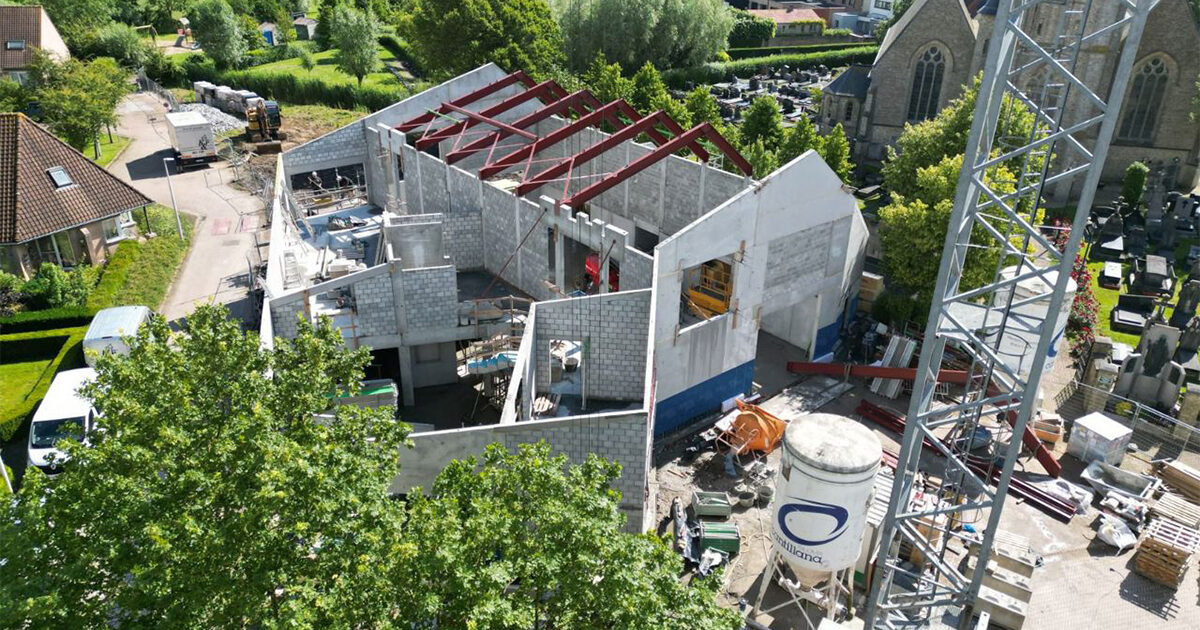
Circular, cement-free and CO2-negative: Carbstone from Masterbloc offers sustainable alternative to classic concrete blocks
It’s widely known that traditional concrete has a significant environmental impact: the production of cement, the binding agent in concrete, releases a lot of CO2, the other ingredients sand, soil and water are not inexhaustible, and at the end of its life, the material is often recycled into lower-value applications such as aggregate for (sub)foundations. For this reason, Masterbloc has had a sustainable alternative to classic concrete blocks in its range for several years: Carbstone. This innovative building material is cement-free, made from a waste product, is CO2-negative due to its specific production process, and can be fully reprocessed into new Carbstone at the end of its life.
Carbstone, developed about three years ago by Orbix in collaboration with VITO, is made from steel slag, a waste product of the steel industry. The binding agent in this innovative stone is not cement, but calcium carbonate, which is obtained by adding CO2 to the stone – a process called carbonatation.
The fact that no cement is needed to make Carbstone makes the stone a sustainable alternative to classic concrete blocks. After all, the cement industry is responsible for 7 to 8% of global CO2 emissions. But there are more reasons why Carbstone’s environmental impact is much lower. The carbonatation process ensures that the stone absorbs more CO2 than is emitted during its production. Moreover, once processed, Carbstone continues to absorb CO2 from the air – which also makes the stone increasingly stronger. Finally, Carbstone is also circular. Not only because the product is made from a waste product from the steel industry, but also because the stone can be fully processed into new Carbstone at the end of its life. This creates a closed material loop.
Sustainable character recognized multiple times
In the Netherlands, the sustainable nature of Carbstone has already been officially recognized in various ways. Shortly after its development, the stone was included in the National Environmental Database (NMD), which means that Carbstone’s environmental performance has been officially measured and approved according to Dutch standards, and the product is therefore objectively measurably sustainable. Dutch architects and engineers use the NMD when calculating the so-called Environmental Performance of Buildings (MPG), a score that indicates how much environmental damage a building causes based on all building materials used and is mandatory for new construction projects, and when calculating the so-called Environmental Cost Indicator (MKI), which expresses the environmental damage of a material or building in euros.
More recently, in January of this year, Carbstone also obtained the KOMO certificate, a Dutch quality mark specifically developed for the construction and infrastructure sector. The certificate confirms that a product, process or service meets the applicable (construction) standards and (building) requirements in the Netherlands, which increasingly contain sustainability criteria. In several of the tests conducted as part of the KOMO certification, Carbstone performed better than standard concrete.
The value of the combination of inclusion in the NMD and KOMO certification should not be underestimated. It guarantees that Carbstone has both a low environmental impact and high constructive quality.
Masonry or bonding
The Carbstone blocks can be both laid with mortar and bonded, and are suitable for both interior and exterior applications – there is also a version with acoustic properties. In our country, Vanhout was one of the first to apply the innovative building block in a project, specifically in the renovation of an office building in Mechelen where OVAM, among others, is housed. “Carbstone is an impressive piece of pioneering work”, said Bert Lenaerts, managing director of Vanhout, at the time. “Its CO2-negativity makes the material an important tool in the fight against climate change.”
In short: Carbstone blocks, which can be both laid with mortar and bonded, and are suitable for both interior and exterior applications, combine ecological responsibility with technical performance. They therefore demonstrate that sustainable construction is possible without compromising on quality and safety. Building with Carbstone is therefore not only an investment in a livable future, but also in quality.
Source: Circubuild, June 25, 2025
